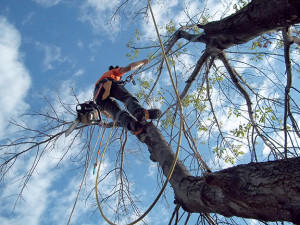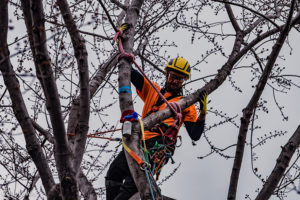Student Experience
Theoretical & Hands-on Experience
 Through theoretical, laboratory and hands-on learning, students develop foundational tree identification and safe tree climbing skills. Becoming an urban forester is about getting outside and getting your hands dirty. From start to finish, our program is hands-on – you’ll be spending a lot of time working with trees and shrubs outside in addition to your time in the classroom.
Through theoretical, laboratory and hands-on learning, students develop foundational tree identification and safe tree climbing skills. Becoming an urban forester is about getting outside and getting your hands dirty. From start to finish, our program is hands-on – you’ll be spending a lot of time working with trees and shrubs outside in addition to your time in the classroom.
In the field, practice and training provide opportunities to become proficient in the use of arborist related equipment such as chains saws, chippers, and stump grinders. In classroom and lab settings, prospective arborists examine tree science and arboriculture practices such as planting, pruning, and removal.
Tree Climbing Competition

Tree climbing is a significant portion of the practical curriculum that is delivered in the Urban Forestry-Arboriculture program. During the eight months of academic studies, students are taught proper tree climbing techniques. Our end-of-year Tree Climbing Competition provides them with an opportunity to showcase their climbing skills for the opportunity to win prizes that will support their career advancement. Our students spend a lot of time in trees as they learn the arboriculture trade. As the students wrap up their program this annual competition is a fun way to demonstrate their tree-climbing ability. Industry professionals from Echo Power Equipment, Universal Field Supplies, Davey Tree Expert Co., Vermeer Canada Inc., Sherrill Tree, and Bartlett Tree Experts also participate in our event to scout for talent during the skills showcase.
What it Means to Be An Urban Forester / Arborist
Algonquin College’s History with Forestry
Our Pembroke Campus of Algonquin College has nearly 50 years’ of experience teaching students about forestry and the enduring careers within the Forestry Sector. Students choose our programs and Waterfront Campus college because of our reputation as educational leaders in the industry.
The City of Pembroke rests on the shores of the Ottawa River and is surrounded by pristine lakes, picturesque farmland, and vast tracts of forest. There is a long tradition of logging in the area and a great demand for every level of trained forestry workers.
One of the earliest records of forestry activity along the Ottawa River dates back to around 1800. That’s when settler Philomen Wright and his family used horses to skid logs along the ice near Hull, Quebec, downriver from where Pembroke would eventually become a major centre for the forestry industry.